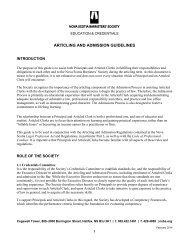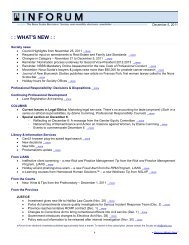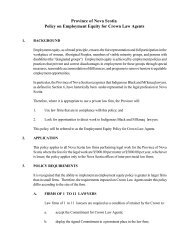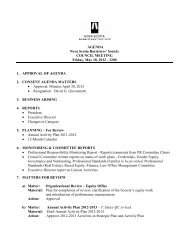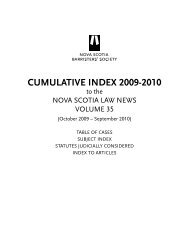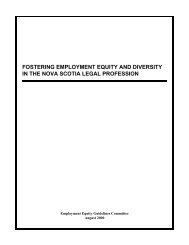SR Vol 24 No 5, October 2006 - Nova Scotia Barristers' Society
SR Vol 24 No 5, October 2006 - Nova Scotia Barristers' Society
SR Vol 24 No 5, October 2006 - Nova Scotia Barristers' Society
- No tags were found...
Create successful ePaper yourself
Turn your PDF publications into a flip-book with our unique Google optimized e-Paper software.
It is curious that the maintenance of access to an impartial tribunalwas recognized for pecuniary losses arising from minor injuries,while eliminating the means of getting there for the non-pecuniarylosses. Claimants electing not to follow the new medical protocols asprescribed by regulation, would be deemed to have sustained a minorinjury, with the resulting legislated restriction on compensation fornon-pecuniary loss to a maximum of $4,000.The Canadian Bar Association had commissioned, prior to thelegislation, an independent study performed by Deloitte & Toucheto determine whether upward pressure on premiums was driven bythe increase in bodily injury payouts. In a report dated September16, 2003, based upon Insurance Bureau of Canada data, the authorsconcluded that, adjusted for inflation, claims costs had in fact beenfalling on a per vehicle basis since 1999.system provides. Moreover, a fair analysis of all of the evidenceindicates that any perceived benefits to business from its tortreform initiatives will be largely, if not totally, illusory.Daniel J. Capra “An Accident and a Dream:Problems with the Latest Attack on the Civil JusticeSystem” 20 Pace L.Rev. 339, 340 (2000)The legal profession, on both sides of the Bar, should increase itsefforts to educate right-thinking members of society in positionsof authority to understand why the tort system is the best modelfor loss allocation, and to reject the calls for quick fixes. And judgesand politicians should be encouraged to recognize that our legalinstitutions are not perfect, but need respect for opposing viewpointsto remain in balance.The Deloitte & Touche report was withdrawn from public scrutinyunder pressure from the Toronto partnership of Deloitte & Touche,concerned about the loss of fee revenue from insurance company clientsof the firm. The Canadian Bar Association complained to the Instituteof Chartered Accountants of Alberta. In hearings held in Edmonton inJune of <strong>2006</strong>, the Institute exonerated the Edmonton authors of thestudy, but disciplined the Central Canada partnership of Deloitte &Touche for having “acted in conflict of interest in compromising theinterest of a client in favour of the perceived interests of other clients,self-interest, or both.” The firm was fined $40,000.The insurance industry has continued to report record profits. For theyear 2004, those profits were reported in Thompson’s Daily InsuranceNews Service on March 16, 2005 to be $4.2 billion in Canada aftertaxes. This was before the effects of the reforms in Alberta and theMaritime Provinces came into being.The impact on the practising Bar has been widespread, and as mightbe expected, largely negative. The effect of the reforms has been torelegate “minor injury” trauma victims to a trivialized status. <strong>No</strong>explanation has ever been offered on why non-pecuniary damageswere arbitrarily reduced in all minor injury cases to a set figure of$4,000, other than to justify “premium stabilization”. A constitutionalchallenge is before the courts, based on S.15 of the Canadian Charterof Rights and Freedoms.In commenting upon the report of a New York business groupadvocating tort restrictions, Professor Daniel Capra stated:The Public Policy Institute’s case for tort reform is not basedon fact. It is simply another part of the onslaught on publicopinion, generated by tort reformers, to create a mindset thatthe tort system is out of control. The attack looks at the costsof the tort system, but not its benefits. It is a carefully craftedattack, ostensibly looking at what is good for society, but onclose analysis focusing only on corporate financial benefits tobusiness. The attack of tort reformers favors cost savings overquality and emphasizes the corporate bottom line over safety.Any arguable savings to business caused by the tort reformsposed by PPI will not benefit society in the long run. Suchchanges would simply shift the cost of the current system toother places, such as a system of social insurance, withoutgiving nearly the same benefits to victims that the currentEd MontagueCampbell Froh May & Rice LLP. Richmond, British ColumbiaIn contrast to the no-fault juggernaut that has significantlyeroded the rights of innocent accident victims in the AtlanticProvinces, and more recently in Alberta over the past few years,British Columbia consumers have managed to retain the right to fullcompensation for personal injuries caused by the negligence of others,with no soft tissue caps or thresholds, while maintaining insurancepremiums among the lowest in Canada for comparable coverage.This has been accomplished under the public auto insurance schemeestablished by the provincial government in 1973 with the creation ofthe Insurance Corporation of British Columbia (ICBC), a provincialcrown corporation which provides universal auto insurance to B.C.drivers. ICBC is a virtual monopoly, in that B.C. drivers are requiredto buy their base auto insurance policy (Autoplan) from ICBC, and canonly purchase optional and additional coverage from outside privateinsurers. The basic Autoplan policy provides a minimum of $200,000third party liability coverage, a healthy component of no-fault accidentbenefits (including up to $150,000 in medical and rehabilitationbenefits and up to $300/week in total disability benefits), a minimumof $1,000,000 in underinsured motorist protection (UMP), and a22 The <strong>Society</strong> Record



